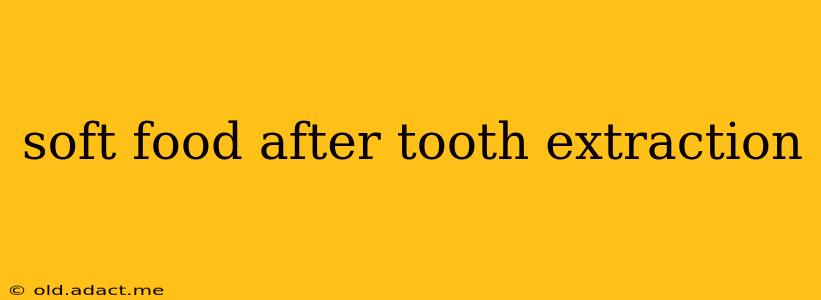Having a tooth extracted can be a bit of a rough experience, and one of the biggest challenges is figuring out what to eat afterwards. Chewing can be painful and uncomfortable, so focusing on soft foods is key to a speedy recovery. This guide will cover the best soft foods to eat after tooth extraction, addressing common concerns and ensuring you’re well-nourished while your mouth heals.
What are the best soft foods to eat after a tooth extraction?
The ideal soft food post-extraction is easy to chew, doesn't require excessive jaw movement, and is gentle on the extraction site. Here are some excellent options:
-
Yogurt: Packed with protein and calcium, yogurt is a fantastic choice. Choose plain varieties and add your own fruits (ensure they are well-mashed or pureed) or a drizzle of honey for sweetness. Frozen yogurt is also a great option for soothing any pain.
-
Applesauce: A classic for a reason! Applesauce is smooth, easily digestible, and provides essential vitamins.
-
Smoothies: Blend fruits, vegetables, yogurt, or protein powder for a nutritious and customizable meal replacement. Avoid anything with seeds or hard chunks.
-
Oatmeal: A warm bowl of oatmeal is comforting and nutritious. Make sure it's cooked until very soft.
-
Mashed Potatoes: A simple carbohydrate source, mashed potatoes are easy to swallow and provide energy for your body to heal.
-
Scrambled Eggs: Scrambled eggs are a good source of protein, but make sure they're cooked until very soft.
What foods should I avoid after a tooth extraction?
It's crucial to avoid foods that could irritate the extraction site or cause complications. These include:
-
Anything requiring chewing: This includes nuts, seeds, chips, popcorn, and tough meats.
-
Extremely hot or cold foods: These can cause discomfort and potentially increase bleeding.
-
Acidic foods and drinks: These can irritate the healing gums. Examples include citrus fruits, tomatoes, and carbonated beverages.
-
Straws: Sucking through a straw can dislodge the blood clot that forms in the extraction site, leading to a painful condition called dry socket.
How long should I eat soft foods after a tooth extraction?
The length of time you'll need to stick to a soft food diet depends on the individual and the complexity of the extraction. Generally, it’s recommended to eat soft foods for at least the first week following the procedure. Your dentist or oral surgeon will provide specific instructions based on your case. Gradually reintroduce firmer foods once the healing process progresses and you feel comfortable chewing.
What if I'm struggling to find suitable soft food options?
If you're having difficulty finding soft food options that you enjoy, talk to your dentist or oral surgeon. They can provide personalized recommendations based on your dietary preferences and restrictions. A registered dietitian can also offer helpful suggestions for a well-balanced, soft-food diet.
Can I eat solid food after a few days?
While some individuals might feel ready to introduce solid foods after a few days, it's crucial to proceed with caution. Start with very soft, easily chewed foods and observe your body's response. If you experience pain or discomfort, return to a soft food diet until you feel fully healed. Always follow your dentist's advice.
Are there any special considerations for children after tooth extraction?
Children may require more assistance and careful monitoring when it comes to their post-extraction diet. Ensure they consume nutrient-rich soft foods to support their growth and development. Consult with your dentist or pediatrician if you have any concerns about your child's diet.
Remember, proper nutrition is essential for healing. By following these guidelines and communicating closely with your dental professional, you can ensure a smooth and comfortable recovery after your tooth extraction. Remember to always prioritize your health and follow your dentist's specific recommendations.
